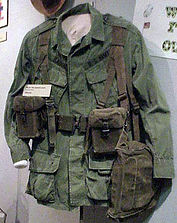
REMEMBERING VIETNAM
Web Gear



Overview:
The load carrying equipment, or web gear, was one of the most important, modifiable, and burdensome parts of a US infantryman's outfit. Offering a high-level of customizability, the web gear provided places for a soldier to store ammo, bandages, water, compasses, maps, grenades, camera film, cigarettes, and nearly any other personal items. It also allowed them to be accessed quickly, providing soldiers with an easy spot to grab another magazine in the thick of a firefight. However, web gear could also be annoying as it would be one of the heavier pieces of kit, and could be uncomfortable.
To make it easier to organize the web gear parts and pieces, this section will be broken down into the earlier model of load carrying equipment, the M1956, and then the newer model, the M1967 lightweight load carrying equipment.
M1956 Load Carrying Equipment:
The M1956 Load Carrying Equipment was the old model, dating back to World War II. There were two variations: the combat mode, which held the necessities for a soldier in a fight, such as ammo, grenades, and the like, and weighing about 40 pounds, and the existence mode, which held everything a soldier would need to carry while in-country such as sleeping gear and additional clothes, and this variation weighed about 60 pounds.
The two basic parts that made up the M1956 were the pistol belt and the field pack combat suspenders. The belt would buckle using a button buckle (other variations would be available), and would have little holes throughout. Attached to the belt would be the suspenders.
Next, there was the field pack, which was like a little bag which would sit immediately against the butt of the carrier, earning it the name "butt pack". It could hold smaller personal items, but not much more than that. Also available was a field pack adapter, which were straps that would pull the field pack up so it was more of a backpack, or to get it out of the water during a river-crossing.
Lastly, attacked elsewhere around the belt were the entrenching tool, used to dig foxholes and such, the first-aid or lensatic compass case, water canteen and cover, and small arms universal ammunition pouches, which would hold magazines full of ammo, and sometimes had places to hold grenades.
M1967 Lightweight Load Carrying Equipment:
The M1967 was made from nylon, as opposed to cotton, allowing it to be more effective in the wet-environments of Vietnam.
The M1967 had the same two key components, a belt and suspenders. It also had a butt-pack, except the new model didn't need to be modified to sit higher on the carrier. It was still small, and provided a good spot for personal items.
Additional pieces like the entrenching tool, first-aid or lensatic compass case, canteen with cover, and ammunition holders also were used with the M1967, with some small adjustments. The entrenching tool now folded, and the ammunition holders made it easier for soldiers to get to mags, adding things like cloth pulls to retrieve magazines.
The straps needed to secure a sleeping bag with the M1956 model were now replaced with a dedicated sleeping gear carrier, which made it easier to carry the items which before, needed to be strapped together.
Citations:
Arques,Antonio. "Load Carrying Equipment." Grunt: A Pictorial Report on the US Infantry's
Gear and Life during the Vietnam War 1965-1975, by Arques, Madrid, Andrea
Press, 2014, p. 199.
---. "M1956 Load Carrying Equipment." Grunt: A Pictorial Report on the US
Infantry's Gear and Life during the Vietnam War 1965-1975, by Arques,
Madrid, Andrea Press, 2014, pp. 200-15.
---. "M1967 Lightweight Load Carrying Equipment." Grunt: A Pictorial Report on
the US Infantry's Gear and Life during the Vietnam War 1965-1975, by
Arques, Madrid, Andrea Press, 2014, pp. 218-27.